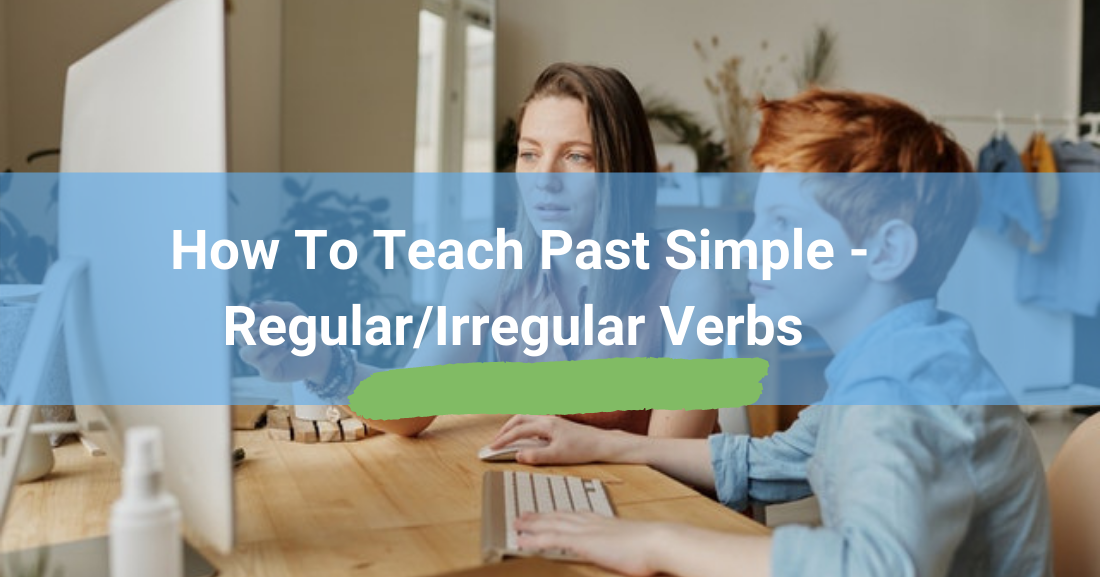
We're often told we should put the past behind us, not dwell in the past, etc…However, ESL students must do just that…to learn the simple past tense. As they learn that regular verbs simply need an –ed suffix, they jump for joy. 'This is not so hard!', they think. Then we hit them with the endless lists of irregular verbs to study, and their enthusiasm deflates like a balloon before your very eyes. Don’t add to the confusion.
Follow these steps to teach the past simple and keep your students right on track:
How To Proceed
-
1
Introduce the Past Simple of regular verbs
Explain that it is the most common way of speaking about things that have happened or are repeated. They are easy to indentify as they follow the same pattern. Give an example in Present Simple: I talk to my sister everyday. Lead into past simple: Yesterday, I talked to them. Write this on the board. Give more examples with regular verbs and write each verb in its past form on the board.
T: I visited her. We watched TV. She cooked lunch. We listened to music.
Make sure students understand that the past form is the same for all persons. Give as many examples with regular verbs as needed. -
2
Practice Past Simple of regular verbs
User sentences to make it easier for students to learn. Go around the class and make statements in present simple, which students must change to past simple:
T: I sometimes walk in the park.
S: You walked in the park yesterday.
T: We often dance at the community center.
S: They often danced at the community center.Now’s a good time to practice the different pronunciations of the –ed past form. Try this worksheet where students are required to group verbs according to their pronunciation.
-
3
Introduce the Past Simple of irregular verbs
First, give an example in present simple: I have lunch at 12 every day. Lead in to past simple: Yesterday I had lunch at 12. Write this on the board. Give more examples with irregular verbs and write each verb in its past form on the board.
T: Yesterday I spoke to a friend. We went to the movies. We saw "Eclipse". My friend ate popcorn. I drank soda. They wrote their names in a book.
Make sure students understand that the past form is the same for all persons. Use this list of the most common irregular words Learning The Irregular Verbs Worksheet. -
4
Practice the Past Simple of irregular verbs
Go around the class and make statements in present simple, which students must change to past simple:
T: I usually drink orange juice for breakfast.
S: Yesterday you drank orange juice.
T: I say we go and watch our team play baseball.
S: You said we should go and watch our team play baseball.
T: I know that her name is Gabriella.
S: I knew that her name was Gabriella.
To help your students study these verbs, give them this worksheet. For extended practice, try Irregular Verb Resources: 21 Fantastic Exercises. -

-
5
Introduce the Past Simple – Negative forms
Say, 'Yesterday I talked to John. I didn't talk to Sarah.' Give more examples alternating between affirmative and negative statements:
Sarah had lunch at 12:00 She didn’t have lunch at 13:00. You went to the gym yesterday. You didn’t go to the movies.
Write the negative form on the board. Then have students do the same, always alternating between affirmative and negative statements. This worksheet The Past Simple (Negative Sentences) helps students construct past simple negative sentences and the rules they should follow.
And so on with all persons, singular and plural. Write the negative form on the board. Then have students do the same, always alternating between affirmative and negative statements. -
6
10 Common Irregular Verbs
Provide a list of the most commonly used words first and encourage the class to try and memorize them. Here is a list of 10 examples to begin with:
1. Say, said, said
2. Get, got, gotten
3. See, saw, seen
4. Come, came, come
5. Know, knew known
6. Think, thought, thought
7. Give, gave, given
8. Become, became, become
9. Make, made, made
10. Tell, told, told -
7
Introduce the Past Simple - Interrogative Forms
The interrogative form is used to ask questions or express situations, events, and actions that happened in the past. Model questions with 'did':
T: Did you come to school yesterday?
S: Yes, I did./No, I didn’t.
T: Ask me!
S: Did you come to school yesterday?
Continue with more questions from students. Model questions with what time, where, when, why, they did something. Write examples on the board. First, they ask you, then they ask their classmates, then they ask a classmate about another classmate. For example: What did Luid do last night? And so on. How did the animals get into the field? Make sure they ask questions in all persons, both singular and plural. If they are unsure how to ask a question, model it for them first. -
8
Introduce the Past Simple - Short Answers
Ask yes or no questions and teach students to give short answers:
T: Did you come to school yesterday?
S: Yes, I did. / No, I didn't.
Students ask classmates yes or no questions, and classmates reply with short answers. -
9
Practice, Practice, Practice
Keep in mind that there are endless options for practice. Ask your students to write about their last vacation for homework. Have them give a presentation on what people did 100 years ago. But no matter what you choose to do, just make sure your students practice the past simple in context. It's the best way to learn!
P.S. If you enjoyed this article, please help spread it by clicking one of those sharing buttons below. And if you are interested in more, you should follow our Facebook page where we share more about creative, non-boring ways to teach English.







